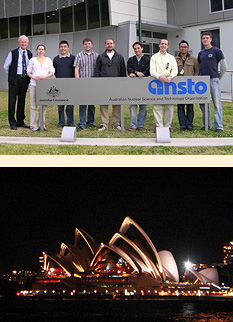News Story
Bruce Attends US-Australian Program in Sydney

Above: MSE graduate student Bobby Bruce (4th from the right) with other selected US students visit the Australian Nuclear Science Technology Organization (ANSTO) Facility in Australia. Below: A view of the Sydney Opera House taken at night from the conference cruise.
Before traveling to Australia, Bruce corresponded via e-mail with his Australian collaborator, Amanda Rider, advised by Professor Ken Ostrikov at the University of Sydney. Rider's research focuses on a numerical simulation approach to modeling nanoassembly of quantum dots on plasma-exposed surfaces.
After arriving in Australia, Bruce spent a week attending talks at the IUMRS-ICEM, while preparing a proposal with Rider and another U.S-Australian team in the program. He also had the opportunity to present the research he conducts at UMD in Oehrlein's Laboratory for Plasma Processing of Materials in an IUMRS-ICEM poster session. His poster was titled "Investigation of Plasma-Polymer Interactions for Patterning Nanostructures."
At the end of the conference Bruce and his collaborators presented their final proposal, which outlined the development of a novel polymer scaffold-on-quantum dot array biosensor. Bruce and Rider thought of an approach to fabricate an array of quantum dot squares with different properties by lithographic patterning and surface modification and subsequent quantum dot growth by plasma. Their fellow collaborators contributed a proposal to use aligned polymer fibers deposited by electrospinning to provide a scaffold for cell growth on top of the quantum dot array. Absorption and reemission of light from colloidal quantum dots within cells would provide a signal that would be picked up by the quantum dot array, providing a dynamic map of cell activity in the polymer scaffold. The resulting novel biosensor has potential use for cancer cell detection and as a monitor for tissue cell growth. The development of a quantum dot array using their techniques would also have potential applications in sensor devices, solar cells, and display technologies.
In addition to the conference, Bruce visited a variety of Australian research institutions, including the University of Sydney, University of New South Wales, and the Australian Nuclear Science Technology Organization (ANSTO), a facility that uses nuclear reactors for materials characterization purposes.
Bruce also made sure to take advantage of opportunities to sightsee in Australia. He dined on a gourmet dinner that included kangaroo fillet and emu carpaccio on the IUMRS-ICEM conference dinner cruise, saw the Sydney Opera House up close, and visited the kangaroos and koalas at the zoo.
"I am grateful to UMD for sponsoring me and NSF for enabling my trip to Australia," he said. "I am happy to have met and worked with such great people and hope a potential collaboration will develop so I can continue working with them."
Related Story:
"Bruce to Attend NSF Program in Australia" »
Published September 11, 2008









